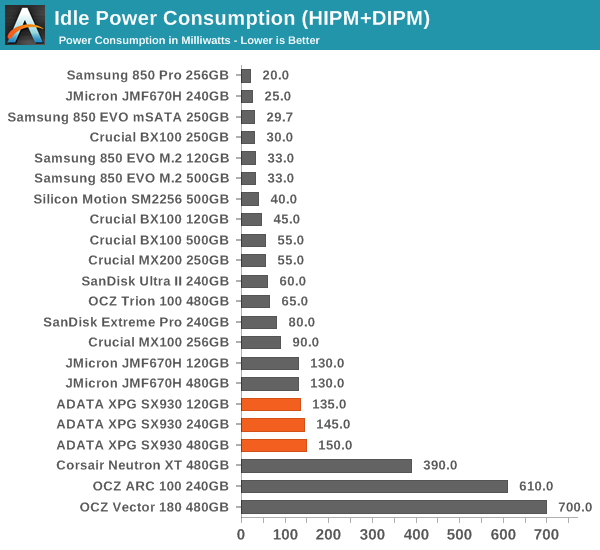ADATA XPG SX930 (120GB, 240GB & 480GB) SSD Review: JMicron JMF670H Debuts
by Kristian Vättö on July 16, 2015 10:00 AM ESTIdle Power Consumption
Since we truncate idle times to 25µs in our Storage Bench traces, they don't give a fully accurate picture of real world power consumption as idle power consumption is not taken properly into account. Hence I'm still reporting idle power consumption as a separate benchmark because it's one of the most critical metrics when it comes evaluating an SSD for mobile use.
Unfortunately I still don't have a way to test DevSleep power consumption due to lack of platform support, but my testbed supports HIPM+DIPM power commands (also referred to as Slumber power), so the results give a rather accurate picture of real-world idle power consumption.

Compared to the reference samples, the SX930 isn't as low power as it could be. I suspect this is due to ADATA's optimizations, which could be to increase compatibility as some systems have issues with power saving states. Still, I would like to see the power saving settings in place because as it stands the SX930 consumes more power at idle than the competing drives with HIPM+DIPM support.
TRIM Validation
The move from Windows 7 to 8.1 introduced some problems with the methodology we have previously used to test TRIM functionality, so I had to come up with a new way to test. I tested a couple of different methods, but ultimately I decided to go with the easiest one that can actually be used by anyone. The software is simply called trimcheck and it was made by a developer that goes by the name CyberShadow in GitHub.
Trimcheck tests TRIM by creating a small, unique file and then deleting it. Next the program will check whether the data is still accessible by reading the raw LBA locations. If the data that is returned by the drive is all zeros, it has received the TRIM command and TRIM is functional.











67 Comments
View All Comments
sonny73n - Thursday, July 16, 2015 - link
LOL @EVO 3-bit NAND...I just threw out my 1 year old 840EVO 250GB which was the worst SSD I've ever had. MX200 500GB is in and I wish I could've got this one from the begining instead of the EVO junk.
Stochastic - Thursday, July 16, 2015 - link
Just curious, what problems did you encounter?fokka - Thursday, July 16, 2015 - link
i guess the same as so many others, which still has no real fix: http://www.anandtech.com/show/8550/samsung-acknowl...Impulses - Thursday, July 16, 2015 - link
That's not about the 850.Adding-Color - Thursday, July 16, 2015 - link
What not about the 850? OP was talking about the 840!futrtrubl - Thursday, July 16, 2015 - link
Actually the OP was talking about something to challenge the EVO, the latest of which is the 850.Samus - Saturday, July 18, 2015 - link
What proof does anybody have the 850EVO is going to be any difference than the 840EVO with performance degradation. They use the same technology and only the 850PRO get's the binned, lower node 3D VNAND.voicequal - Monday, July 20, 2015 - link
The 840EVO was on ~19nm NAND. The 850EVO uses 40nm V-NAND which should provide much greater cell integrity needed for TLC operation.sonny73n - Friday, July 17, 2015 - link
What about the 850? After my experience with that "EVO", Samsung 3-bit TLC NAND in particular, I had lost interest and trust in Samsung. The 830 Pro 128GB I had years ago was excellent though but it took a chunk out of my pocket. So I guess when it comes to value for the money, I should always look somewhere else.bug77 - Friday, July 17, 2015 - link
Then you don't know that the 850 EVO has *nothing* to do with 840 EVO. Not surprising, otherwise you wouldn't have bought that PoS. The planar TLC is bottom of the barrel, with slow access and probably under 1000 P/E cycles. The 850 EVO uses 3D NAND which alleviates those issues.So you see, it really wasn't an 840 EVO problem, it was a planar TLC NAND problem. Many cheap drives still use that.